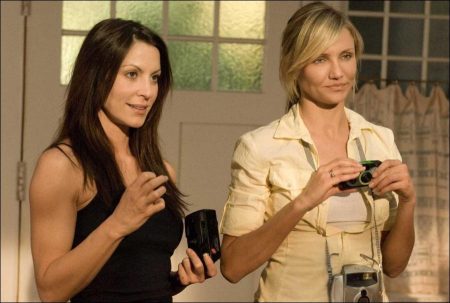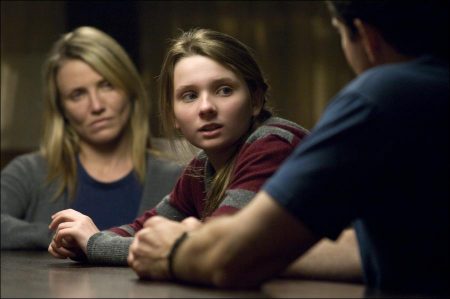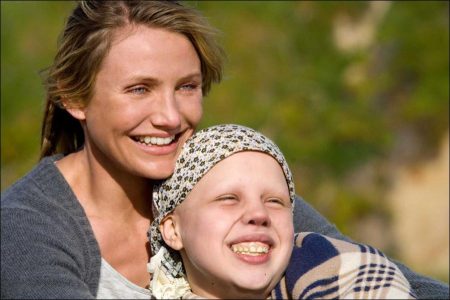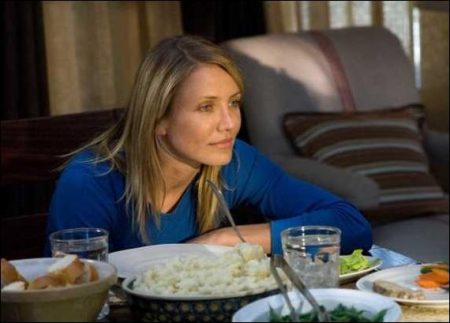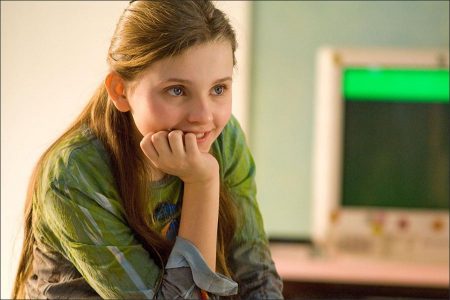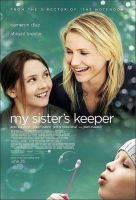Sara and Brian Fitzgerald’s life with their young son and their two-year-old daughter, Kate, is forever altered when they learn that Kate has leukemia. The parents’ only hope is to conceive another child, specifically intended to save Kate’s life. For some, such genetic engineering would raise both moral and ethical questions; for the Fitzgeralds, Sara in particular, there is no choice but to do whatever it takes to keep Kate alive. And what it takes is Anna. Kate (Sofia Vassilieva) and Anna (Abigail Breslin) share a bond closer than most sisters: though Kate is older, she relies on her little sister—in fact, her life depends on Anna.
Throughout their young lives, the sisters endure various medical procedures and hospital stays—just another part of their close-knit family’s otherwise normal life. Sara (Cameron Diaz), a loving wife and mother who left her career as an attorney to care for her daughter, is sometimes lost inside the single-minded caregiver she has become in her efforts to save Kate. Her strong, supportive husband, Brian (Jason Patric), is often rendered powerless by his wife’s determination. And their only son, Jesse (Evan Ellingson), drifts, at times all but forgotten as Kate and Anna take center stage. Until Anna, now 11, says no. Seeking medical emancipation, she hires her own lawyer (Alec Baldwin), initiating a court case that divides the family… and that could leave Kate’s rapidly failing body in the hands of fate.
My Sister’s Keeper is a 2009 American drama film directed by Nick Cassavetes and starring Cameron Diaz, Abigail Breslin, Sofia Vassilieva, Jason Patric, and Alec Baldwin. Based on Jodi Picoult’s novel of the same name, on June 26, 2009 the film was released to cinemas in the United States, Canada, Ireland, Mexico, and the United Kingdom.
In its opening weekend it placed 5th with a total of $12,442,212, behind Transformers: Revenge of the Fallen, The Proposal (second weekend), The Hangover (fourth weekend), and Up (fifth weekend). The film left theatres on October 8, 2009 with a domestic total of $49,200,230 with a further $46,459,927 from foreign markets. It has grossed $95,660,157 worldwide.
About the Production
“When I was a kid, my mother told me that I was a little piece of blue sky that came in to this world because she and Dad loved me so much. It was only later when I realized that it wasn’t exactly true.” – Anna
When Sara Fitzgerald gave birth to Kate, she and her husband Brian rejoiced over their new baby girl. But joy turned into fear when their beloved child was diagnosed with a rare form of leukemia. Kate’s health became the fulcrum of the family, which grew with the birth of her sister Anna. But Anna wasn’t just another welcome addition. She was a necessity, conceived as a perfect genetic match, specifically designed to save Kate’s life. Cameron Diaz, who stars as Sara, relates, “When I first read the script, it was just one of those stories that haunted me. I connected with Sara, but I didn’t always agree with her, and that interested me.”
Eleven years into this routine—endless medical procedures, complications and hospital stays—Kate’s kidneys are failing. She needs a new one, so, as they have for all of her young life, her parents look to Anna. But Anna, all of 11 years old, says, for the first time, “What about me?” And, for the first time, she refuses to give up a part of herself for her sister Kate. Instead, she decides to sue her parents for the rights to her own body.
Anna’s decision will have profound and dire consequences. “Anna knows that her parents are going to be mad at her, that everyone is going to think she’s selfish and mean,” says young actress Abigail Breslin, who plays Anna. “But there is more to her decision; she has her reasons.” “My Sister’s Keeper” is based on Jodi Picoult’s provocative novel of the same name. By the time it attracted the attention of filmmaker Nick Cassavetes, it was already the author’s best-selling work and a beloved topic of discussion and debate in book clubs worldwide. In films as disparate as “John Q,” “Alpha Dog” and “The Notebook,” Cassavetes has investigated the nuances of the human condition, the nature of love and free will and human dignity—all themes that resonate in Picoult’s book.
“When I read the novel, I was very moved,” says Cassavetes. “I started thinking about the movie as a simple story about how a family could deal with facing the death of a child, and I thought, ‘This is a story I’d like to tell.’”
Producer Mark Johnson adds that, in addition to the book’s compelling themes and characters, the structure lent itself well to film. “At its core, the book is about family and that really speaks to so many readers. Jodi taps into issues and situations to which we all connect and makes us wonder how we might react. What she also does very cleverly in the book—and hopefully we do in the film—is tell the story through multiple narrators, so you get the sense of the entire family speaking. It’s incredibly rich material for a filmmaker—an intimate family drama with huge implications, which is something that Nick really gravitates toward and understands,” Johnson notes.
Although several of Picoult’s books have been adapted for television, “My Sister’s Keeper” marks the first time her work will be brought to the big screen. “I’ve always believed that this story could work on screen, but I was especially excited when I learned it would be a feature film,” the author reveals. “Then to have the cast and the director they assembled, that is truly remarkable.”
To adapt the work from book to screenplay, the filmmakers knew it was important to find a screenwriter who appreciated and respected the novel’s themes and gradations, in addition to character and plot. “My Sister’s Keeper” reunites writer/director Cassavetes with screenwriter Jeremy Leven, with whom he previously collaborated with great success on “The Notebook.”
Leven, who, apart from his filmmaking career, has a background in child psychology, neuroscience and psychopharmacology, offers, “I suppose that my medical training gave me some added understanding. I really felt it was important to be sensitive to what this family was dealing with,” Leven attests, “and how a mother’s entire life can be defined by her investment in saving the life of her child, sometimes at the expense of others in the family. But, simply being a parent to five children myself and experiencing how a parent is so involved in the well-being of his or her children, gave me more insight than anything else.”
Johnson, who also produced “The Notebook,” believes that the Cassavetes/Leven combination was right for this project because “Jeremy has the ability to tell a very sensitive story but is also able to rein it in and, in so doing, make it more real. Nick directs the same way.”
The producer also admires Cassavetes’ way of working with actors. “I think the audience believes in the story, the characters and the situations because Nick has a way of making it feel real, that it is something that could happen. He takes a story that could potentially be overly sentimental, but doesn’t allow that to happen because he peoples it with very real and true performances,” Johnson says.
“Just so you know, I’m not going to let her die. I’m not.” –Sara In the pivotal role of the family matriarch, Cameron Diaz was the first actor cast. The part of the single-minded mother of a sick child intrigued her because her first reaction to Sara Fitzgerald was profound.
“I wanted to understand her, who she was, how she became that way and why she makes the decisions she does,” she says. “That exploration was very compelling to me and I thought it would be challenging to try to tell her story.”
“For me, this movie is serious on so many levels,” notes Cassavetes, “and there are a finite number of actresses that you think of for this type of role. Each of them has an impressive body of work. But I really didn’t want to cast an actress who had done something similar for this film.”
Perhaps better-known for her comedic roles, it was Diaz’s dramatic performances that appealed to Johnson. “I’ve been a fan of Cameron for a long time and, frankly, her dramatic roles are among my favorites. I think what she did in ‘In Her Shoes’ was remarkable; she was astonishing in ‘Being John Malkovich,’ in ‘Vanilla Sky’…the list goes on. Cameron was our first choice for Sara, and I remember when we first found out she was interested, Nick and I looked at each other and said, ‘Can you believe how lucky we are?’” Johnson remarks.
“Cameron’s great in whatever she does,” offers Cassavetes, “and I’m so proud of her work in this film. She had to dare to be unsympathetic, because the character of Sara has tunnel vision; everyone around her seems to have some perspective, and she’s just ‘Save her, save her, save her, save her.’”
In the process of inhabiting Sara Fitzgerald and portraying her staunch devotion to her sick child, Diaz learned not to evaluate her. The character is not easily delineated as “good” or “bad,” but rather navigates a murky moral area; Diaz instead tried to empathize with her and to understand the terrible situation that led to her actions.
In preparing for the role, Diaz says, “I talked to parents who had sick kids and to their children, to try to understand what it would be like to be in this position. The truth is you can’t know what you’d do unless you’re in her situation; until you have a deathly ill child, there is no way to say to what lengths you would go to save that child. And I thought that was very interesting to examine, because we love to judge people, don’t we? But, with Sara, I found that impossible to do,” Diaz remarks.
Kate, Sara’s daughter who is afflicted with leukemia, is played by Sofia Vassilieva. While her character lives with the specter of death throughout the film, the teenaged actress says it was the universal bonds of family presented in the script that attracted her to the part.
“The beautiful, intricate relationship this family develops and the connections they form appealed to me,” says Vassilieva. “Although not all families go through something as drastic as the Fitzgeralds do, the story of how one person can affect the entire family unit struck me as very real, touching and beautiful.”
She was particularly drawn to Kate’s spirit and her love of life. “Because Kate is so close to death, she appreciates everything—every smell, every bird, every breath is precious to her—all the things we take for granted. There is a sort of purity to her that grabbed me; she is one of the most incredible characters I have come across so far,” Vassilieva says.
Kate’s counterpart and lifeline, Anna, is the catalyst for the sudden change in course the family goes through. “I really believed that the lynchpin of the film had to be Anna, that the honesty of her emotions were what was going to anchor the film,” says author Jodi Picoult. Already an Oscar®-nominated actress, Abigail Breslin, who turned 12 during production, committed entirely to Anna, whose lawsuit against her parents is waged out of an abiding love for her sister and family.
“I remember reading the script for the first time and saying to my mom, ‘I have to be this girl.’ I just loved it. I loved all the characters, I loved the family—it was something I had to do,” Breslin says.
Breslin initially worried that the mood on set might be sad and intense, but says this was not the case. “When I found out I got the role, I thought, there are parts of this that are so sad, everyone is going to be very serious about it all. But everyone was very nice and it was so much fun. Some of the scenes were sad but the set was not,” Breslin recalls.
She attributes this atmosphere to her director, who kept the mood light, the pace quick, and offered a supportive but firm approach. “Nick was always really fun and I felt like he was always there for me. You can talk to him about anything. And he’ll always listen to what you have to say about the movie or your role, or really anything that you want to talk about. He will always let you try out your ideas. He’s just really cool,” Breslin says.
Eschewing elaborate rehearsals, Cassavetes opted for a more spontaneous approach, and created a safe emotional environment for his actors. In particular, he never talked down to his younger cast members, always treating them with respect as fellow artists.
“You find yourself talking with ‘babies’ about the most personal and deep things, major questions in life, and that they are able to understand better than you,” the director marvels. “As a person that’s older than they are, you feel you must be the teacher; but in many ways they are the teachers. Whether it’s a testament to their talent, or to their great insight as human beings to be able to feel and understand these kinds of things, I don’t know. But I really got lucky.”
Picoult was particularly excited about the seasoned Breslin taking on the role of Anna. “Anna is the one who’s the heart, and I honestly cannot think of another actress Abby’s age that I would’ve trusted as much with that role.”
The author remembers a set visit she made during the filming of a particularly emotional moment for the character. “I watched her film a scene where Anna is crying at Kate’s bedside when Kate’s very, very sick. And I watched them do this scene…I don’t know…eight or 10 times in a row. And after Nick would yell ‘Cut,’ Abby would start laughing about something. And then she would do the scene again beautifully. And I just thought, ‘This little girl is incredible.’”
While Anna’s mother is fixated on saving her sister, Anna’s unprecedented refusal to help forces her father to start looking at things from a different perspective. Jason Patric takes on the role of Brian, Sara’s loving but increasingly frustrated husband.
“Pairing Jason with Cameron felt like one of those exciting situations where one and one make more than two, one of those combinations where you say, ‘I wonder what that will bring forth,’” states Johnson.
“Brian is really the one who is torn,” observes Patric. “He and his wife have sort of a Solomon-type problem, choosing between the needs of the two girls, but he is more conflicted. His wife is dead-set on her course, but he thinks more about balancing the needs of both children.”
Johnson notes, “I have made several movies with Jason and he is a strong dramatic actor who really immerses himself in his roles. Nick had been a big fan of his, too. Jason really wanted to know who Brian was, so we spent several days in an intensive dialectic trying to mine his place as a father, a husband and a man enmeshed in this big drama.”
Completing the family are Heather Wahlquist as Sara’s sister and confidante, Aunt Kelly, and Evan Ellingson as Jesse, Sara and Brian’s teenage son who finds himself somewhat lost in the family shuffle. The young actor, Diaz points out, really blossomed as Jesse, and the part became more and more pivotal over the course of shooting.
“It was amazing to watch. He and Nick kept adding more to the role because Jesse was clearly so big a part of the Fitzgerald puzzle. Evan is a lovely soul and it was wonderful to watch this happen,” she says.
“When Anna Fitzgerald first stepped into my office, I thought she was selling Girl Scout cookies.” – Campbell Alexander
Coming to Anna’s legal aid is Campbell Alexander, the charismatic lawyer who takes Anna’s case. Alec Baldwin stars in the role, and though much of his screen time takes place during the highly charged courtroom scenes, in between takes he often regaled his director and castmates with jokes and stories. Ironically, one of the movie’s main draws for Baldwin was that it was not a comedy.
“Well, I’m doing a TV show that is a comedy, so the chance to do a tough, emotional drama was very attractive.” Baldwin describes his character as “a larger-than-life attorney with billboards all over town, who has a very self-promoting quality. Interestingly enough, that’s all it takes for Anna to hire him: she says, ‘You’re the guy on the bus.’ More discerning people might not hire him, but 11-year-old girls? He’s got that demographic,” the actor laughs.
Perhaps Baldwin does as well. Picoult visited the set several times but, on one occasion, she had her 12-year-old daughter with her. The author recalls, “At the time, his daughter was also 12. And during the breaks, when he wasn’t on camera, his entire modus operandi was to make my daughter giggle—anything he could do to make her laugh. And I loved that.”
Mark Johnson agrees. “Alec makes me laugh, not just because he’s funny, but because he’s funny in such an original, unexpected, idiosyncratic way. And I so embrace his work because what you want an actor to do more than anything is surprise you. He’s just one of those actors that, as a producer, you sit off to the side of the set watching him work and you say to yourself, ‘I can’t believe we got him.’”
When Anna’s emancipation case brings the Fitzgerald family’s predicament into the courtroom, they meet Judge De Salvo, who presides over the trial. De Salvo has been dealing with her own heartache, so the timing of Anna’s lawsuit is particularly challenging for the character. Joan Cusack stars in the role, which, Johnson reveals, was originally written for a man.
“Bringing in Joan as Judge De Salvo was an inspired bit of casting by Nick,” the producer says. “Obviously, Joan is known for her comedies. But Nick is so good at finding the unconventional but entirely appropriate actor, and that’s what makes his work interesting to watch.”
Rounding out the cast are Thomas Dekker as Taylor, another cancer patient who becomes romantically involved with Kate, and David Thornton as Dr. Chance, Kate’s longtime oncologist at the hospital.
Johnson sums it up. “Nick is so good at the unconventional. Often I’ll read a script and say, well, this person’s right and that person’s right. But Nick will say the fact that they’re right makes them inappropriate, find somebody who’s not right and have him or her make that part work, it’ll be better. And I think we’ve done a lot of that in this movie.”
“I want to go to the beach. I want to see the waves.” —Kate “My Sister’s Keeper” was shot almost entirely in Los Angeles. The production’s locations spanned from Downtown to the beaches of Malibu and Santa Monica to the stately neighborhoods of San Marino.
Whenever possible, the production filmed in practical locations, underscoring Cassavetes’ penchant for realism. To capture the sequences at the fire station where Brian Fitzgerald works, the production moved into Engine 27 in Hollywood, where real firemen were on hand as advisors. The hospital sequences were shot in the shuttered Daniel Freeman Hospital.
Cinematographer Caleb Deschanel’s work underscored the movie’s naturalistic sensibility. The camera moves were spare and performance-driven; occasionally, he and Cassavetes let the entire scene play out even if they might only use a portion of it, to encourage and support the actors’ process.
The hair, make-up and costume departments also hewed closely to reality. Sara Fitzgerald, a woman in crisis, so singularly focused on her child, has no time for or interest in personal glamour and her look reflects it. Dark roots peek through Diaz’s blonde hair and, throughout most of the movie, she is devoid of make-up.
Costume designer Shay Cunliffe dressed the Fitzgerald family in basic tshirts, cardigans and jeans, favoring hues of blue and gray. In keeping with Sara’s make-up and hair, the character often wore the same outfit over and over, conveying that she was consumed by bigger issues.
The only “colorful” character was Abigail Breslin’s Anna, who wore pinks and browns, stripes and plaids. Cunliffe purposely dressed her differently and slightly rebelliously, as she is the one who turns the family’s life upside-down. The most extreme makeover, however, was reserved for Kate. To expose the ravages of her disease and the effects of the grueling treatments to cure it, Vassilieva wore contacts that caused her eyes to appear bloodshot and cloudy, and a subtle, ghostly layer of make-up that mottled her skin and sunk her eyes, giving her a pallor that reflected her character’s increasing debilitation.
But, in the most demanding test of her dedication, the young actress, who came into the production with a mane of long blonde hair, shaved her head and eyebrows. While the actress is quick to point out that her bald pate did not nearly approximate what real cancer patients undergo, she says it certainly was a start toward understanding it.
“Shaving my head was an extraordinary experience that caught me off guard and frightened me; then I realized that Kate is too beautiful a character and that shaving my head was a sacrifice that needed to be made,” Vassilieva says.
It helped, she adds, that she had a technical advisor in the form of 16- year-old Nicole Schultz, who is a vivacious leukemia survivor, now with a full head of blonde hair. “Nicole has become one of my great friends. Her battle with leukemia was very similar to Kate’s and she knew when I needed support more than anyone else. When I was shaving my head, to provide an escape from the bittersweet reality, we chanted ‘Fuzzy Wuzzy was a bear, Fuzzy Wuzzy had no hair,’” Vassilieva smiles.
“Ask a kid to shave her head and her eyebrows for a movie…let’s put it this way: I felt out of line even asking,” declares Cassavetes. “But she’s quite a kid,” he says of his young star.
Because Vassilieva appears in a regular role on the television series “Medium,” the production fashioned her hair into a wig that she could wear on the show until her own grew back. She will then donate it to Locks of Love, the non-profit organization that supplies hairpieces to financially disadvantaged children suffering from long-term hair loss due to any medical condition. Indeed, wigs figured heavily into Sofia’s role, as she had to wear several different ones throughout the film. A special wig schedule was devised to keep track of them all during the shoot.
Like Vassilieva, Thomas Dekker, who plays Taylor, a young man Kate meets during chemotherapy, also shaved his head. He found it to be a liberating and enlightening experience. “What was most interesting about it was life outside the movie. People treated me very differently because they assumed that I had cancer. I often got these very pitying or strange looks, and it gave me a small idea of what it must be like to go through life like that, singled out as a sick person,” Dekker says.
Of course, part of what draws the characters of Kate and Taylor together is their shared understanding. Dekker adds that he, Vassilieva and Cassavetes all wanted to emphasize the joy and camaraderie in Kate and Taylor’s relationship. “I think for Kate, Taylor brings a lot of humor and love into her life in a way that only another person who has gone through the cancer experience can. We wanted to stress the fun and silliness they enjoy together, as well as their affection for each other, because we figured if your life was really short, you’d try to have as much fun as possible in the time you have,” Dekker explains. Adding to the cast and filmmakers’ own understanding of what cancer patients go through were the extras and technical advisors, who were often one and the same.
“One of the things we did for authenticity’s sake is make sure that our actors and extras in the hospital were as close as possible to the people who would actually be there,” offers Johnson. “And we had a number of patients who came and worked with us in various ways and really helped us to better understand so much about the movie we were making.”
Throughout the production, Ileana Geestman and her organization, The Desi Geestman Foundation, provided information and advice about cancer-stricken children and how the illness affects them and their families, both physically and emotionally. The foundation’s mission is “to improve the quality of life for children suffering from cancer and their families. The foundation provides environments of support that alleviate emotional and economic trauma.” The charity was named in honor of Ileana’s daughter, a brave 12-year-old girl who fought a courageous battle with neuroblastoma at The City of Hope. Ileana arranged for several of the children affiliated with her foundation to appear as extras and to serve as de facto advisors for the cast and crew.
“I got a phone call one day from City of Hope,” Geestman recalls, “asking if our foundation wanted to participate in the movie…and maybe I could specifically answer some questions from the perspective of a mom having gone through this with my child. I thought it would be a wonderful opportunity not only to help but also to bring awareness to the children, their disease and their families. Having said that, my initial reaction was also one of protection because of what the children and their families go through—I wanted to make sure they were taken care of and that they were not going to be exploited in any way and that they would be treated as regular kids.”
Geestman was more than pleased with the result. “All of that happened—tenfold. Nick told me he wanted to keep the movie as real as possible and asked if some of the children would participate, and completely reassured me that they would be taken care of and respected. The children loved meeting and working with everyone on the set; Nick was so friendly with them and talked to them on their level. Sofia was a real sweetheart—they all felt like she was their best friend. The kids really wanted to be a part of it. We took some of them out of the hospital and it became an adventure for them. And these adventures are so important because their journey sometimes gets very lonely at the hospital. So their involvement in the movie brightened their lives tremendously,” Geestman affirms.
“I guess you could say we’re a little dysfunctional, but everybody loves each other, and we do the best we can.” – Anna The presence of these young people also brightened the days of the entire cast and crew.
“Making ‘My Sister’s Keeper’ was one of the most amazing, joyous experiences I’ve had,” Cameron Diaz reveals. “It was a very serious movie about a serious subject, but the tone Nick set for the film, the way he is telling the story, is the complete opposite of what you might expect. He never tried to play on those heartstrings or go for the obvious tearjerker moment; what he created instead was something vital and full and immediate. Just when you think it’s about death, you realize it’s really about life. Before we even started the movie, he told me that we would laugh a lot and have a good time.”
Reflecting on her own experience making the film, Abigail Breslin offers, “You know, it’s sometimes hard when you’re doing such hard scenes, crying scenes…you get kind of sad sometimes. But when it’s over, you have to know that you’re just telling a story and you’ll be okay. And everybody on set was so nice and so much fun, it was one of the best times that I’ve ever had on a movie.”
“It’s like anything else,” asserts producer Mark Johnson. “You want to see a story that fascinates you and you want to see who you might be able to identify with, react or respond to in that fascinating story. There is a sense of, ‘If I were in this situation, what would I do?’ And I’m not for one moment saying that I would have done what all of these characters did. It comes down to that notion of ordinary people living through extraordinary events. And I think this particular story speaks to something that’s very important to me. It speaks to family. And there’s something so wonderful about the strength of a family.”
“These kinds of things don’t just happen to people who are ready for it,” offers Nick Cassavetes. “Most of the time, you’re not ready for this sort of thing at all. But as human beings, we must trust in ourselves and in our capability to make the right decisions with the amount of information we have. The future of medicine is going to keep bringing up many ethical and moral questions the further we go. But this is our children’s world and our children’s children’s world, and how we handle it, well, that’s why this story interested me—it’s universal. That’s why I made this film.”
My Sister’s Keeper (2009)
Directed by: Nick Cassavetes
Starring: Cameron Diaz, Alec Baldwin, Abigail Breslin, Jason Patric, Thomas Dekker, Sofia Vassilieva, Joan Cusack, Nicole Marie Lenz, Olivia Hancock, Emily Deschanel, Jeffrey Markle
Screenplay by: Jeremy Leven
Production Design by: Jon Hutman
Cinematography by: Caleb Deschanel
Film Editing by: Jim Flynn, Alan Heim
Costume Design by: Shay Cunliffe
Set Decoration by: Maggie Martin
Music by: Aaron Zigman
MPAA Rating: PG-13 for mature thematic content, some disturbing images, sensuality, language and brief teen drinking.
Distributed by: New Line Cinema
Release Date: June 26, 2009
Visits: 107
